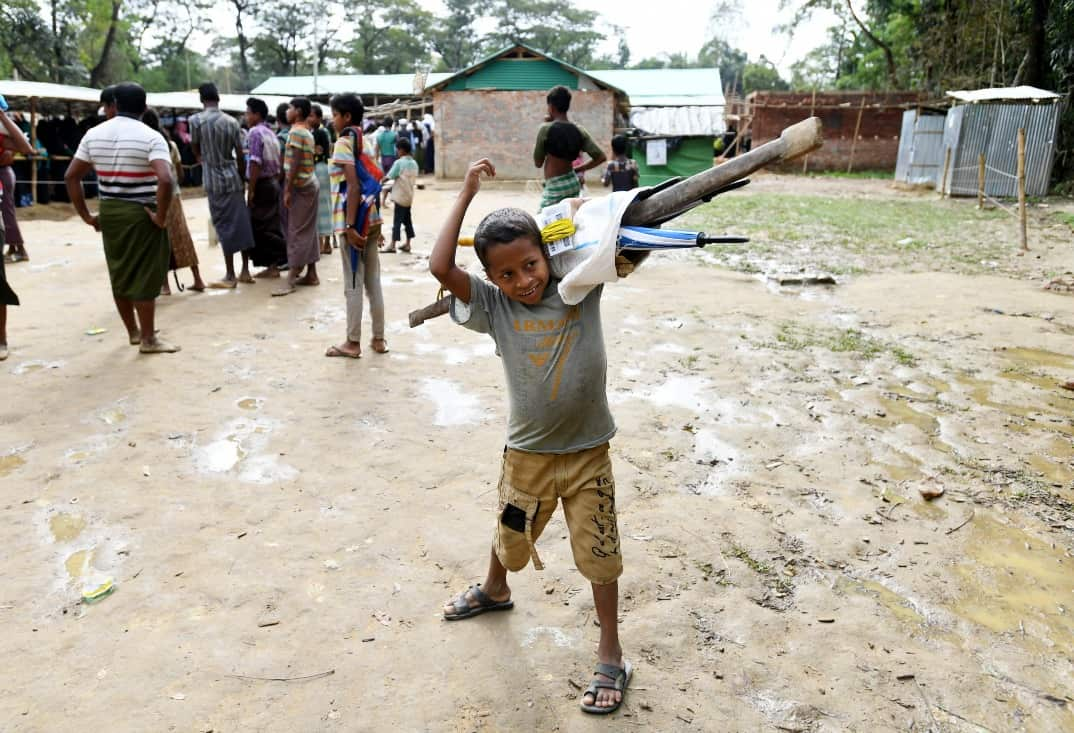Tracey Nearmy is a photographer with Australian Associated Press. She travelled to Bangladesh with assistance from Save the Children to witness the work the organisation is doing to help more than 646,000 Rohingya refugees who have crossed the border from Myanmar following the Myanmar army's August crackdown on Rohingya rebels in the state of Rakhine.
I was invited by to cover their work on the ground providing aid and health care to the Rohingya refugees who had crossed the border from Myanmar to Bangladesh.
My role as a photographer is to tell the story of the Rohingya refugees in the truest way possible.
When I got there the new arrivals were still in the process of rebuilding day-to-day life, the distraction of those tasks holding back the shock and the terror for the time being.
Their minds were filled with the tasks at hand - building, cleaning, starting small businesses and making sure they had a space in the queue to receive the daily aid rations. Aid workers were amazed by the speed with which the Rohingyas went about setting themselves up, clearing the dense jungle where the camp now stands within months or arriving.
Aid workers were amazed by the speed with which the Rohingyas went about setting themselves up, clearing the dense jungle where the camp now stands within months or arriving.

Rohingya refugee Janet Ara with her 27-day-old boy Mohammad Arshat in front of their shack at the Balukhali refugee camp in Bangladesh on December12, 2017. Source: AAP/Tracey Nearmy
Now toilets, mosques and child friendly spaces dot the hillsides where a rainforest recently stood.
Sanitation is an issue, as aid organisations do their best to set up the segregated male and female toilets, which need to be far enough apart to make the women using them feel comfortable, sturdy enough to cope with the high demand, and accessible for the trucks to remove the sludge. At the moment the refugees' basic needs are being met but outbreaks of disease are occurring due to the low sanitation and high density population.
At the moment the refugees' basic needs are being met but outbreaks of disease are occurring due to the low sanitation and high density population.

A nurse runs a health check on a malnourished Rohingya child at a health centre run by Save the Children at the Balukhali refugee camp. Source: AAP/Tracey Nearmy
Aid organisations are scrambling to deal with diphtheria at the moment, which has 804 reported cases and has claimed 15 lives. Some 73 per cent of the suspected cases are children under the age of 15, and all but one of the 15 mortalities have been children.
With the monsoon season approaching more durable housing and better sanitation is desperately needed. In some camps frayed tempers were on show. A heavy feeling lay over the rows of orange tarp roofs as the reality of their situation combined with their spare time provided glimpses into the psychological scarring of the residents.
In some camps frayed tempers were on show. A heavy feeling lay over the rows of orange tarp roofs as the reality of their situation combined with their spare time provided glimpses into the psychological scarring of the residents.

A Rohingya woman carries a child over sandbags through water lying on the ground at the Balukhali refugee camp in Bangladesh on December 11, 2017. Source: AAP/Tracey Nearmy
People reacted with hospitality and curiosity to our visit. People only had the most basic possessions, and options for entertainment were limited, and so we became objects of interest and entertainment.
Working in that environment is interesting because you want to capture natural moments while they happen - photographing people at their most unguarded and natural is what we aim for to present events in their truest form.
It was sometimes a challenge to direct attention away from myself. Occasionally I had to wait until my subjects' interest in me had passed so I could photograph them. Having grown up without screens or phones or televisions the children had very long attention spans so it could take a long time for them to focus elsewhere! I delighted in playing a game with three young girls, stacking up plastic drink bottles and containers, and knocking them down as we crouched in the gloom on the packed earth floor. The face of a girl no older than five lit up with laughter as I crashed a broken plastic sheep into the tower.
I delighted in playing a game with three young girls, stacking up plastic drink bottles and containers, and knocking them down as we crouched in the gloom on the packed earth floor. The face of a girl no older than five lit up with laughter as I crashed a broken plastic sheep into the tower.

Rohingya children fly handmade kites at the Balukhali refugee camp near Cox's Bazar in Bangladesh on Tuesday, December 12, 2017. Source: AAP/Tracey Nearmy
Children followed us through the camp yelling hello and goodbye, or chatting away in Rohingya.
One child kindly picked up a hood for my camera lens which had fallen off, and then proceeded to follow us all the way out of the camp, happily yelling goodbye as we left.
I was surprised that often there was an air of calm and sense of getting on with life in the camps. Children quietly hugged the tree line of the food distribution centre as the adults patiently lined up to receive their daily rations. There was a patience that comes with knowing there is enough aid to go to everyone - a testament to the fantastic work being done by the aid organisations on the ground and the industrious nature of the Rohingya.
The conditions in the camp were miserable - mud-caked pathways wound between flimsy shacks made from woven bamboo and tarps. It was stifling and dark inside the shacks and, with no way to secure the doorways, they left women and children vulnerable.
It was stifling and dark inside the shacks and, with no way to secure the doorways, they left women and children vulnerable.

A Rohingya child in her shack which she shares with two families at the Balukhali refugee camp near Cox's Bazar in Bangladesh on Monday, December 11, 2017. Source: AAP/Tracey Nearmy
Groups of families were crammed together, sharing spaces not much bigger than your average bedroom and sleeping on plastic mats on the packed dirt floor. The average family size is eight, and at times there were three families sharing one shack.
There was constant movement throughout the camp as bamboo poles and bricks were carried on the shoulders of both men and children.
Trucks inched through the narrow, muddy tracks between the flimsy structures, passing alarmingly close to street-smart toddlers.
Shacks were kept meticulously tidy, and young mothers manage to keep their babies clean, even without nappies or face washers. The lack of basic supplies has lead to a sea of bare-bottomed toddlers running around. We spoke mostly to women who made the journey across the border when they were eight or nine months pregnant.
We spoke mostly to women who made the journey across the border when they were eight or nine months pregnant.

Rohingya refugee Janet Ara with her 27-day-old baby boy Mohammad Arshat in a cradle swing made from a rice sack at the Balukhali refugee camp on December 12. Source: AAP/Tracey Nearmy
One woman walked for 15 days through the jungle without food to reach the camp, while another was attacked and kicked in the stomach as she fled.
Upon seeing smoke rising from the gaps in one tarpaulin, I asked through hand gestures to enter the shack of a woman and child who were eating the lunch she had just cooked. They kindly offered to share it with me, which I politely declined, not wanting to take away from their precious rations.
This hospitality and generosity was evident throughout the camp. Even with very little, the refugees were charitable towards each other.
One woman had sold her jewellery to be able to afford a pedal-powered sewing machine, making garments for fellow camp-dwellers and only taking as much payment as they could afford.
Some of the Rohingya people in the camp want to go home, others are unwilling to return to Myanmar. A permanent solution to the crisis is what they all want. The refugees need a safe place to call home where they can rebuild their lives. The images that struck me the most was seeing children looking after other children and doing tasks that we’d normally give to adults, like carrying heavy loads, bathing each other and walking to the forest to collect fire wood alone.
The images that struck me the most was seeing children looking after other children and doing tasks that we’d normally give to adults, like carrying heavy loads, bathing each other and walking to the forest to collect fire wood alone.

A child carries umbrellas on his shoulders at the Balukhali food distribution centre near Cox's Bazar in Bangladesh on Monday, December 11, 2017. Source: AAP/Tracey Nearmy
In some families only the children were left to care for each other, taking on roles well beyond their years.
The trip made me realise how lucky I am in life. I left Bangladesh with the greatest respect for the Rohingya, the pride, resilience, kindness and generosity they have, even when they are at their most vulnerable.
I hope that the work I produced in the camps helps to change in the attitudes towards the Rohingya, particularly in Myanmar, and inspires people to help them in any way they can over Christmas and into 2018.

